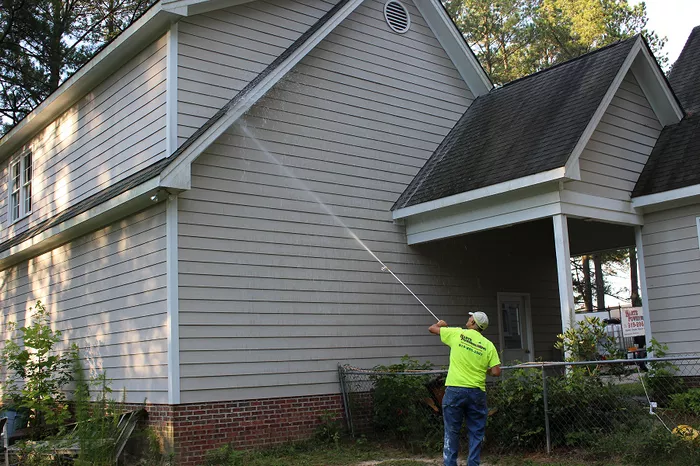Maintaining the exterior of your home is crucial for preserving its beauty and structural integrity. Over time, dirt, grime, and mildew can accumulate on surfaces, detracting from your home’s appearance and potentially causing damage. Pressure washing is a highly effective solution for cleaning various exterior surfaces, from siding to driveways, restoring them to their original glory. In this guide, we will delve into the essential steps and considerations for safely and effectively pressure washing your house.
Introduction to Pressure Washing
Pressure washing involves using a high-pressure stream of water to remove dirt, grime, mold, and other contaminants from surfaces. It is an efficient and environmentally friendly method for cleaning exterior surfaces without the need for harsh chemicals. By utilizing the power of water pressure, pressure washing can quickly rejuvenate the appearance of your home’s exterior, enhancing curb appeal and prolonging its lifespan.
Safety Precautions
Before embarking on a pressure washing project, it’s crucial to prioritize safety. Begin by securing all windows and doors to prevent water from seeping into your home. Additionally, wear protective gear, including safety goggles, gloves, and sturdy footwear, to shield yourself from potential hazards. Be mindful of electrical outlets and fixtures, and avoid spraying water directly at them to reduce the risk of electrical shock.
Equipment Overview
Pressure washers come in various types, including gas-powered, electric, and commercial-grade models. When selecting a pressure washer, consider factors such as water pressure, flow rate, and nozzle attachments. For softer surfaces like wood or vinyl siding, opt for a lower-pressure washer to prevent damage. Conversely, tougher surfaces such as concrete or brick may require higher pressure for effective cleaning.
Preparation Steps
Proper preparation is key to achieving optimal results with pressure washing. Start by removing any obstacles or debris from the area to be cleaned. Cover delicate plants, outdoor furniture, and fixtures to protect them from the high-pressure spray. Inspect the exterior of your home for any signs of damage or loose siding, and make any necessary repairs before proceeding.
Cleaning Solutions
While water alone can effectively clean many surfaces, using a cleaning solution can enhance the results, especially for removing stubborn stains or mold. There are various cleaning agents available for use with pressure washers, including environmentally friendly options. When using cleaning solutions, always follow the manufacturer’s instructions and properly dilute them to avoid damaging surfaces or harming nearby vegetation.
Step-by-Step Guide
1. Equipment Setup: Start by assembling your pressure washer according to the manufacturer’s instructions. Connect the appropriate nozzle for the task at hand, ensuring a proper fit to achieve the desired water pressure.
2. Test Spray: Before tackling large areas, test the pressure washer on a small, inconspicuous area to gauge its effectiveness and adjust the pressure as needed.
3. Begin Cleaning: Work in small sections, starting from the top and working your way down to prevent streaking. Hold the nozzle at a slight angle and maintain a consistent distance from the surface to ensure even cleaning.
4. Overlap Passes: Overlap each pass by about 50% to ensure thorough coverage and consistent results. Pay special attention to areas with heavy staining or mildew buildup, applying additional pressure if necessary.
5. Rinse and Repeat: Once you’ve completed cleaning the entire surface, rinse it thoroughly with clean water to remove any residual dirt or cleaning solution. Allow the surface to dry completely before assessing the results.
Troubleshooting Tips
Despite your best efforts, you may encounter challenges during the pressure washing process. Here are some common issues and how to address them:
1. Streaking: Adjust the nozzle angle and pressure to ensure even coverage.
2. Surface Damage: Reduce the pressure or switch to a softer nozzle to prevent damage to delicate surfaces.
3. Clogged Nozzle: Clear any debris or obstructions from the nozzle using a pin or needle to restore proper flow.
Post-Cleaning
After completing the pressure washing process, allow the exterior of your home to dry thoroughly before assessing the results. Depending on the surface material and weather conditions, this may take several hours to a full day. If you plan to repaint or apply a protective coating, ensure the surface is completely dry and free of any residues before proceeding.
Professional Services
For homeowners who prefer to leave the pressure washing to the experts, hiring a professional pressure washing service is an excellent option. Professional cleaners have the experience, equipment, and expertise to tackle even the toughest cleaning jobs safely and effectively. Additionally, they can provide valuable advice on maintaining your home’s exterior between cleanings, helping to preserve its beauty and value for years to come.
Conclusion
In conclusion, pressure washing is a valuable tool for homeowners seeking to maintain the cleanliness and appearance of their home’s exterior. By following the steps outlined in this guide and prioritizing safety, you can achieve professional-quality results while prolonging the lifespan of your home’s surfaces. Whether you choose to tackle the task yourself or enlist the help of professionals, regular pressure washing is essential for preserving your home’s beauty and value.

